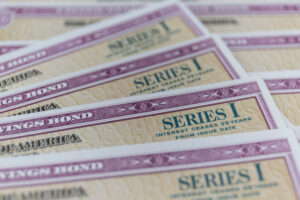
Is rising inflation affecting your financial plan? Protecting the bulk of your wealth is mostly about building and maintaining a well-structured investment portfolio with a few anti-inflation elements. Outside of your core portfolio, there’s an inflation hedge to consider that might work for you. Consider purchasing U.S. Series I Saving Bonds (I Bonds), whose payouts are indexed to inflation, with a portion of your emergency funds or similar cash reserves.
What Are I Bonds?
I Bonds are inflation-indexed savings bonds issued by the U.S. Treasury. Practically speaking, the interest you earn on your I Bond is the sum of two rates: a fixed rate and an inflation rate.
The fixed rate is based roughly on prevailing economic conditions. The inflation rate is based on inflation, as measured by the Consumer Price Index for all Urban Consumers, or the CPI-U. However, the U.S. Treasury guarantees your I Bond will never be worth less than what you paid for it, so your composite rate will never drop below 0%.
The Treasury adjusts I Bond rates every six months, on the first business day of each May and November. What are current rates for I Bonds purchased from May–October 2022? The fixed rate is an annualized 0% for the life of the bond. The inflation rate is an annualized 9.62% for at least the first six months. After that, your bond’s inflation rate may rise or fall over time, based on the Treasury’s semi-annual November/May rate changes.
In other words, if you purchase an I Bond today, you are essentially guaranteed to earn a 9.62% annualized interest rate for the next six months. If inflation remains high after that, so too will your I Bond’s interest payments.
Purchasing I Bonds
I Bonds are only sold directly to you, the public, through an account you establish at TreasuryDirect.gov.
Maximum Investments
You can purchase up to $10,000 in I Bonds per person, per year. An additional $10,000 can be purchased through a personal trust.
Liquidity
Once you purchase an I Bond, you must hold it for at least a year (with a few hardship exceptions). You may hold it for up to 30 years before it comes due. If you cash out after 1 year but before 5 years, you lose the last three months of interest.
Tax Ramifications
I Bond interest is subject to Federal income tax but exempt from state and local income taxes. Federal tax due on the interest earned may be deferred until you redeem the bond.
Best, Highest Use
It’s always satisfying to score strong returns on any given holding. But if you do decide to purchase I Bonds, where will the money come from, and how else could you have used it? If you’re thinking about tapping your greater portfolio to buy I Bonds, how do they fit into your structured investment plan? If you plan to use cash reserves already allocated for upcoming expenses or emergency reserves, make sure the one-year holding requirement won’t become a cash-flow problem if unexpected expenses arise.


 What Will Your Retirement Look Like? No Really.
What Will Your Retirement Look Like? No Really.